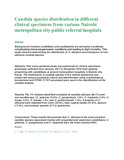| dc.contributor.author | Sigei, E. C. | |
| dc.contributor.author | Nyamai, M. | |
| dc.contributor.author | Kitolo, S. M. | |
| dc.contributor.author | Okinyi, V. P. | |
| dc.contributor.author | Bii, C. C. | |
| dc.contributor.author | Were, T. | |
| dc.date.accessioned | 2024-01-15T14:59:00Z | |
| dc.date.available | 2024-01-15T14:59:00Z | |
| dc.date.issued | 2023-10-27 | |
| dc.identifier.uri | https://www.ajol.info/index.php/eamj/article/view/258020 | |
| dc.identifier.uri | http://ir-library.mmust.ac.ke:8080/xmlui/handle/123456789/2563 | |
| dc.description.abstract | Background: Invasive candidiasis and candidaemia are pervasive conditions complicating immunosuppressive conditions and leading to high mortality. This study aimed at determining the distribution of C. albicans and emergence of non-albicans candida species.
Methods: This cross-sectional study was performed on clinical specimens previously collected from January 2017 to December 2018 from patients presenting with candidiasis at several metropolitan hospitals in Nairobi city, Kenya. The distribution of candida species in the clinical specimens was conducted using mycological culture and identification using morphological, biochemical and VITEK® 2 YST automated were used in the identification of the candida isolates.
Results: The 141 isolates identified consisted of candida albicans (66.7%) and non-candida spp. (C. glabrata, 16.3%; C. parapsilosis, 7.8%; C. tropicalis, 3.6%; C. krusei, 2.8%; C. famata, 1.4%; and C. guilliermondii, 1.4%). A majority of C. albicans were obtained from urine (33.3%), high vaginal swabs (31.9%), sputum (17.0%), and tracheal aspirate (5.7%) specimens.
Conclusions: These results demonstrate that C. albicans is the most prevalent candida species associated mainly with urogenital and respiratory candidiasis. C. glabrata, C. parapsilosis, and C. tropicalis were the most common NAC. | en_US |
| dc.language.iso | en | en_US |
| dc.publisher | East African Medical Journal | en_US |
| dc.subject | Candida, species, distribution, different, clinical, specimens, various, public, referral ,hospitals | en_US |
| dc.title | Candida species distribution in different clinical specimens from various Nairobi metropolitan city public referral hospitals | en_US |
| dc.type | Article | en_US |

